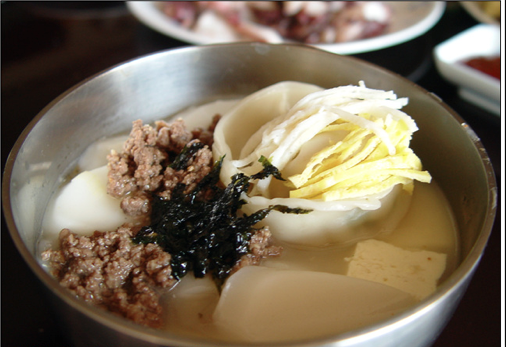 Xiaolongbao
Xiaolongbao (simplified Chinese:
小笼包) is a type of steamed bun or
baozi from the Jiangnan region of China, especially Shanghai and Wuxi. It is traditionally steamed in small bamboo baskets, hence the name (
xiaolong is literally
small steaming basket).
Xiaolongbao are often referred to as
soup dumplings or simply
dumplings in English.
The characters that make up "
xiaolongbao" translate literally to "small", "steaming basket" and "steamed buns (
baozi)", and the whole term may be literally translated as "little-basket buns".
The similarities between the appearance of
xiaolongbao and
jiaozi (dumpling) has meant that the
xiaolongbao is sometimes classified as a dumpling outside of China. It is, however, distinct from both steamed and boiled
jiaozi in texture and method of production, and is never regarded as a
jiaozi (which is more usually translated as dumpling) inside China. As is traditional for buns of various sizes in the Jiangnan region,
xiaolongbao are pinched at the top prior to steaming, so the skin has a circular cascade of ripples around the crown, whereas
jiaozi are usually made from a round piece of dough folded in half, and pinched along the semicircle. Instead,
xiaolongbao is usually regarded as belonging to a whole family of various steamed buns of various sizes sometimes collectively known as
tang bao, literally "soup bun": see "related varieties" below.
Chinese buns in general may be divided into two types, depending on the degree of leavening of the flour skin. Steamed buns made with raised flour are seen throughout China and are what is usually referred to as
baozi. Steamed xiaolongbao made with partially raised flour are more commonly seen in the south. This means that their skin is tender, smoother, and somewhat translucent, rather than being white and fluffy.
Xiaolongbao are traditionally filled with pork, but variations include other meats, seafood and vegetarian fillings, as well as other possibilities. One popular and common variant is pork with minced crab meat and roe. The characteristic soup-filled kind are created by wrapping solid meat aspic inside the skin alongside the meat filling. Heat from steaming then melts the gelatin-gelled aspic into soup. In modern times, refrigeration has made the process of making
xiaolongbao during hot weather easier, since making gelled aspic is much more difficult at room temperature.

Traditionally the
xiaolongbao is a kind of
dim sum or snack item, as well as a kind of
xiaochi or "small eat". The buns are served hot in the bamboo baskets in which they were steamed, usually on a bed of dried leaves or on a woven mat, although some restaurants today use napa cabbage instead. The buns are usually dipped in Chinkiang vinegar with ginger slivers. They are traditionally served with a clear soup.
The buns are traditionally part of Jiangnan-style morning tea. In Cantonese regions and the West it is also commonly served as a Cantonese
yum cha item. While not traditionally eaten as part of a main meal, some restaurants have in recent years begun serving
xiaolongbao as a main dish.
Frozen
xiaolongbao are now mass-produced and a popular frozen food sold worldwide.
Posted by Yuan Jia











































.JPG)